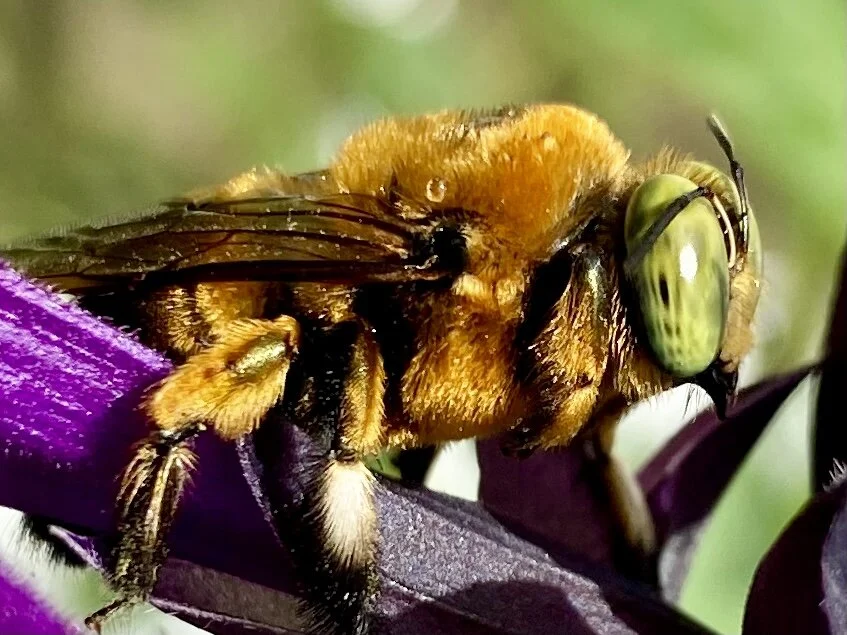After discussing Symbiosis with a local philanthropist she recommended I write an informative article about native bees for one of the local neighborhood publications. Thawing Out Texas is the result of that discussion. I consider it part of the installation.
Thawing Out Texas
After our beloved energy city state buckled under extreme weather conditions again —I think we have an opportunity to strengthen our city.
Your neighbor, I am also a citizen conservationist and abstract-artist-activist who fell in love with Houston in the '80s for its "can do" culture and courage to separate from the herd of national conformity mentality. By diversifying the plants we select to replace the now crunchy brown traditional non-native plants with non-hybrid native plants, we can lead our city and state and change the course of insect and bird extinction. With some of the most gifted creative gardeners in Texas, I trust we can find a way to redefine urban landscape.
In 2017, I started studying the bee situation pertaining to my art and my interest in regenerative agriculture/carbon sequestration in urban settings after learning the U.S. Fish and Wildlife Service listed the Rusty Patch Bumble Bee on the endangered species list. The campaign to list a species as endangered is lengthy and complicated. With this system, it is difficult to gauge how many species are endangered. Scientists predict that without pollinators, human life can only continue for four years. A true Houstonian, I love food — with the thought of losing tomatoes and Texas blueberries, I dove deeper into my bee research.
What I learned is the honey bee is great for making honey, industrializing agriculture and growing mono-crops, but for pollination, the bees we need in our neighborhoods and organic regenerative farms are native species. Native bees are responsible for pollinating 75% of the world's flowering plants; they are crucial for producing most fruits, nuts, and berries – our agriculture depends on pollination by native bees. Native bees are not easy to study; most of them are solitary bees living in dead stems, holes in rotting trees, and under our lawns. They cannot be industrialized, so there is little funding to research their habits and needs. They are much like the people drawn to Houston— independent, hard-working, and focused on energy.
Rural areas are highly impacted by the unanticipated consequences of our industrial agriculture's dependence on chemicals that weaken honey and native bee immune systems. Urban bee populations can be more diverse than in rural areas. In cities such as Chicago, Berlin, Berkley, and Melbourne, they have reimagined their greenspaces with native flowers, grasses, and fruits and vegetables researchers finding healthy, vibrant wild native bee populations.
In the U.S., there are four thousand native bee species, and they pollinate over three hundred times more effectively than honeybees. For example, a single female Leafcutter Bee visits 100,000 plus blossoms per day, whereas a honeybee visits 50-1,000. Unlike the honey bee, Native bees do not swarm, are not aggressive. Native bees are perfect for urban population centers.
I start every morning with a long walk through my neighborhood’s streets and since I became bee-aware, I have seen a dramatic decrease in native bees in our yards. During COVID quarantine, I noticed an even more dramatic drop in native bee and insect numbers. Listening to my favorite soil biologist Allan Savory speak about earth conservation, his dealings with the USDA and activating change, he says that scientists and biologists can only do so much: artists and writers must create the visual images of change. I was already pretty deep in this rabbit hole, so it was not that big of a leap for me to commit my art practice to art activism with a focus on restoring ecological balance in Houston's urban landscape. In 2021 I am installing large-scale, site-specific works, titled Symbiosis at Lawndale Art Center and Endangered Knowledge: The Soul of Humus, for Sculpture Month Houston 2021, alongside Rumblings, a collection of fifty monoprints of wild native bees.
Houston covers 600 square miles of land and has one of the longest growing seasons in the U.S. As it continues to expand across Texas, its gardens must increasingly become a refuge for native plants and animals. With 2.3 million people living in the most vital economic, cultural center of the south, we can become the most critical urban native bee habitat in the United States.
Here, in Texas's most influential neighborhoods, is an enormous opportunity to change our residential landscape to support the wildlife that is vital to our existence and help mitigate extreme weather occurrences. The latest research supports that to rebuild native bee populations; we need to plant non-hybrid native plants, reduce pesticides in our gardens, including mosquito control devices, and replace artificial ground covers with flowering ground covers. The last twelve months have taught us that we can change. I invite you, my Texas neighbors, to step-up, separate from the herd; use your Texas "Thaw," and speak-up for Texas birds, bees and butterflies.
Left: a photo of a male Xylocopa micans, the Southern Carpenter bee. Xylocopa m. uses buzz pollination essential to pollinate tomatoes, eggplants, and peppers. Honey bees are too small to pollinate these foods. Xylocopa m. prefers to nest in dead woody plants and is not found to nest in building frames like Xylocopa virginia.
Abstract watercolor monotype of Xylocopa m. buzz pollinating in my garden. A detail from Rumblings.
30” X 44” detail 1 of 50 a work in progress


